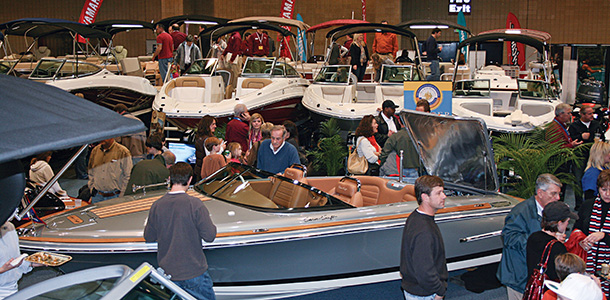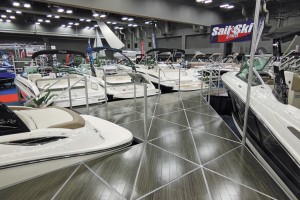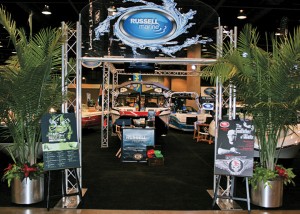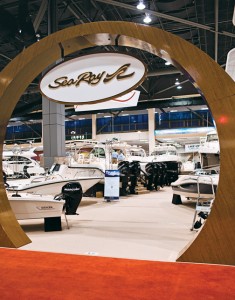Boat show sales success

How top dealers ensure positive ROI on big-ticket shows
Once late fall hits, and boats head for storage, the sales season has basically been put to rest. But instead of spending all their time focusing on the past, many dealers are looking forward because as winter hits and the new year begins, boat show season will be upon us.
Though boat shows aren’t the grand events they were pre-recession, many dealers are still pulling in more than a quarter of their annual new unit sales from these events. The key to doing so, they say, is careful preparation, great performance at the show and immediate follow up.
Pre-show
That preparation begins long before show time, while the regular selling-season still holds a pulse. Many dealers start making considerations for their January and February shows in July or August of the year before. And some start even earlier.

Kevin Roggenbuck, president and owner of Lake Union Sea Ray, with four locations in Washington state, starts looking at his next year’s show strategy as soon as the current year’s show season is complete.
“We talk about what we did wrong, what went right and what we’re going to do,” Roggenbuck explained.
Though intensive training doesn’t start until November, that sit down shortly after the shows end allows the staff to share their thoughts while the last show is still fresh in their minds. Then they can wait until late fall for BoatCamp, Lake Union Sea Ray’s month and a half of boat show training for sales staff and managers.
BoatCamp begins with the group determining goals, deciding what to sell at the shows, considering special pricing and studying effective sales strategies. Each of the dealership’s three or four teams is then assigned a certain aspect of the show strategy to research and present to the group at the end of camp.
“We believe that three-quarters of the people that end up buying boats at the show don’t come to the show prepared to buy a boat, so the more prepared we are, the more likely we are to triple or quadruple our sales,” Roggenbuck said.
He learned over the years that as traffic dwindles in November, December and January, staff can become lazy, so it’s essential to amp up their excitement, so they’re fully prepared to sell.
“We consider our boat show our Super Bowl, and it’s the beginning of our season, so we have to be ready for the people to be walking through the door in the January, February time frame,” Roggenbuck said.
The Sail & Ski Center, winner of the 2012 Top 100 Best Boat Show Strategy Award, starts its show planning in August, when ordering units for 2014.
“We want to make sure we’re ordering any new models or any new product early, so we have them for the January shows,” president Rod Malone said.
Following the ordering process, The Sail & Ski Center begins looking at the layout of each show. The dealership uses a computer program to electronically design their exhibit area, so it’s prepared for those who set it up.
“We can lay out the boat show display electronically, move things around, size things and get a really good indication of what the show is going to look like pretty early on. It allows us to plan the move in and move out effectively,” Malone said.
A theme holds the booth together, and it is usually associated with one or two brands that have the most exciting product for the year. In 2014, for example, one of the focuses might be on pontoons, since that market is hot right now.
As November creeps in, Malone begins training his staff for the three shows they’ll attend in January. The prep includes product review and sales training.
“It’s really not anything magic, it’s just a discipline to plan and be prepared when you get there, rather than trying to wing it at the last minute,” he added.
In Alabama, Russell Marine takes part in two major boat shows, in addition to the 10 or so it hosts each year. Planning for those two shows starts about five months early, when the 25-30 staffers who will be attending are each assigned a pre-show responsibility.

entrance, plush carpets, fresh greenery and more.
The booth is a marketing piece that Russell Marine puts a big emphasis on. The goal is to have a “wow factor,” as the dealership is aiming to have the best display at each show. The store looks at every aspect of the exhibit, from the carpet, to the lighting, to the greenery, to the closing booth, to the pro shop.
“We also want to make sure that we have a display that’s customer friendly where the customer can’t only see the outline of the boat really well but also see the inside and be able to get in the inside really well,” president Dave Commander said.
His staff hones their skills in training sessions that last the entire two weeks before show season.
“It gets them very familiar with the brands that we carry; it gets them familiar with the motors that we carry; it gets them familiar with how to work with a customer, and the other thing — the biggest thing — is we want to get them excited about the upcoming season and get them in the frame of mind that they can show this excitement to the customers out there,” Commander said.
Making sales
With the right preparation, boat shows can contribute much to dealerships’ bottom lines, but solid execution of those strategies is crucial to good performance.
At a successful show, dealers can get in front of tens of thousands of customers, but it behooves the dealers to attract some key prospects as well. To do so, Russell Marine sends a special invitation to its likely-to-buy prospects. The dealership budgets up to $3,000 each year to buy tickets for those customers, so they can get into the show for free and visit Russell Marine’s booth.
“Yes, we’re looking for new customers, but I’d say the majority of our boat sales at boat shows are with current customers that we’ve been working with, so it gets them to the show to do that,” Commander said.
Bob McCann, director of education at ARI, advises dealers to build excitement about each show early in the week, as soon as setup starts. By posting photos and videos of setup and, later, of exciting things going on at the show, even outside of the dealership’s booth, stores can attract more people to the show. It’s a better way to build attendance than just promoting special pricing.
“Get them to the show; show them it’s a great time,” he said. “When you get them to the show, by then, the story’s got to come in line that obviously it’s the best time of the year to buy.”
To assure those attending the shows in the Austin, Texas, area are high-quality prospects, The Sail & Ski Center has worked with the Austin and San Antonio boat dealer associations to establish them as the owners of the local shows. Through those associations, Sail & Ski and its competitive dealerships have guaranteed that the shows focus on boating and don’t bring in attractions such as hot rods or music acts just to increase head count. As a result of this, the dealership has been able to create a selling event out of the shows it attends.
“Our vision is that we are attending a boat sale not a boat show,” Malone explained. “Our primary goal is to sell units at the show. There are less expensive ways to meet prospects. That being said we obviously take advantage of meeting and developing a relationship with future buyers.”
Follow up
Though sales are the number one priority for most dealerships, McCann advises that dealers keep in mind that some prospects won’t be ready to buy at a show, no matter the pitch.
“[Dealerships] typically have a firm goal on the number that they want sold, but they don’t have the goal — where I think is the big opportunity — is the leads they pick up.”

Those leads, he says, see a number of dealerships throughout their time at a show, so it’s important to follow up quickly to set themselves apart from the pack. McCann recommends that whenever possible, follow-up on prospects should start at the show and never wait until the week after, because many employees get busy once back in the dealership and forget to follow up.
“When the mornings are slow, call people and thank them for stopping by,” McCann advised.
A same-day or next-day call is a goal of The Sail & Ski Center. Though the dealership prefers to close sales during the show, Malone knows the importance of keeping up with those most likely to buy in the near future.
“Prospects who could be buyers before the show closes or shortly thereafter are followed up with by voicemail, email, or text as early as the same day of the visit or certainly by the next day. Appointments are made, and a plan of action is determined for each potential buyer,” Malone said, adding that those with longer-term buying frames are logged into a database and followed up with at a later time.
Lake Union Sea Ray has a similar same-day follow-up policy.
“We follow up during the show as well. If someone comes in at the boat show, we’re following up that day or the next day. At the boat show, we certainly have our sales crew on the phone,” Roggenbuck explained.
After the initial phone call, prospective customers will also receive an email from Roggenbuck thanking them for stopping by and explaining how Lake Union Sea Ray is prepared to help them with their boating needs.
Russell Marine emails prospects immediately after their visit. The staff then meets each morning and afternoon of the show, as well as one and two weeks after the show, to discuss prospect follow-up.
Boat show vitality
Though boat shows have seen decreasing attendance over the last five years or so, many dealerships still see them as significant events to boost sales.
“Boat shows are still an effective and efficient way for a consumer to view and compare different types and brands of boats, particularly those consumers with a specific desire for ownership, so if there is value to the consumer, there is value to us as a boat dealer,” Malone said.
As customers spend more time searching the Internet than taking the time to drive to their local dealership to research new models, Commander, who has started a number of boat show events himself, believes it’s important to go where the consumers are.
“Now that the boat business is a little tough these days, I think it’s more important to have a boat show and to take the boats to the customer instead of waiting on the customers to come to you.”
Though boat show investments are becoming increasingly hard to make, as revenues are down for many dealerships and exhibit expenses seem to be rising, with the right plan, Roggenbuck finds there is a huge benefit to continuing to attend shows.
“I think that our industry, our collective involvement in boat shows needs to be more than just writing a check,” he said. “It needs to be the energy we put into them, and we’ll get a direct return related to that energy.”




